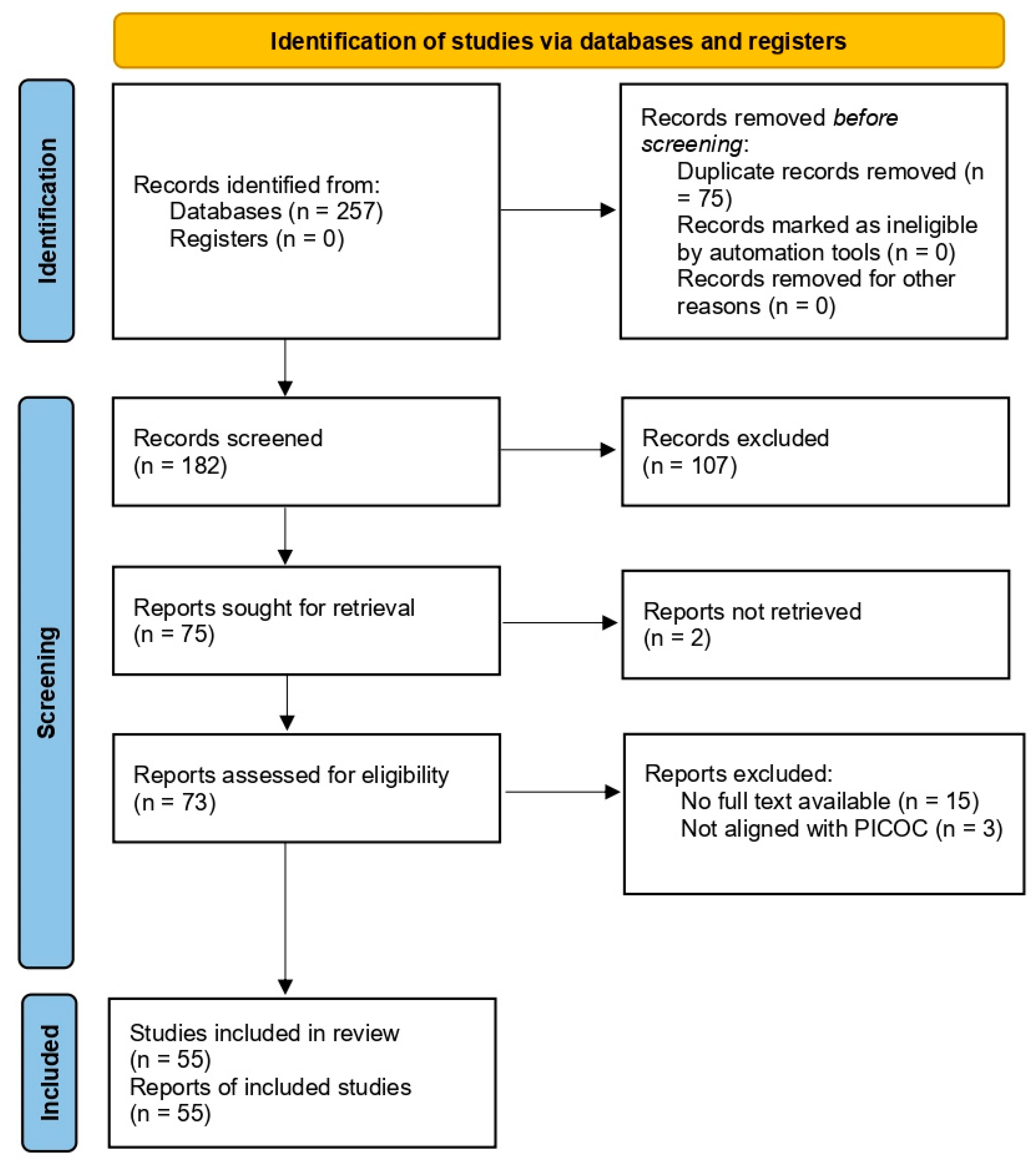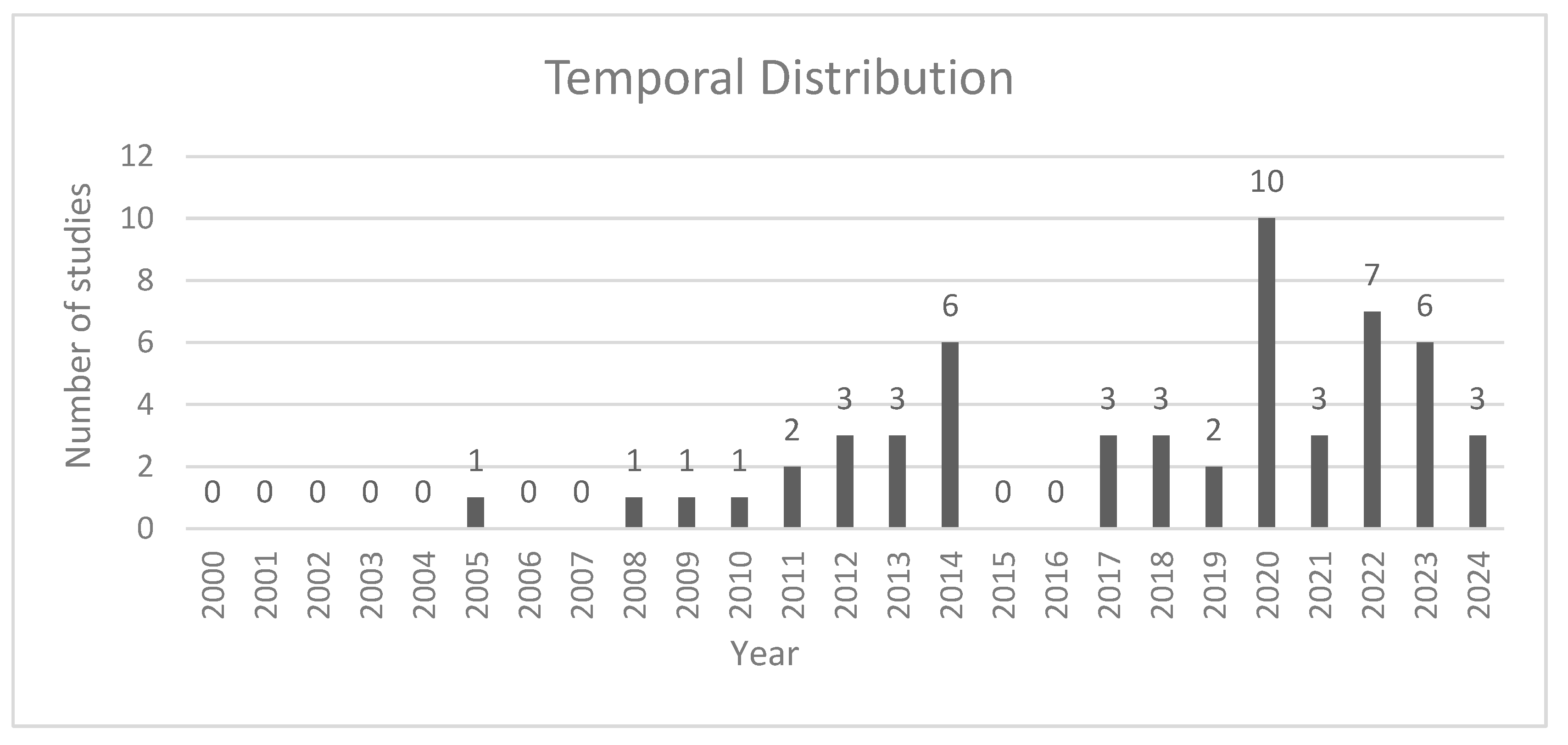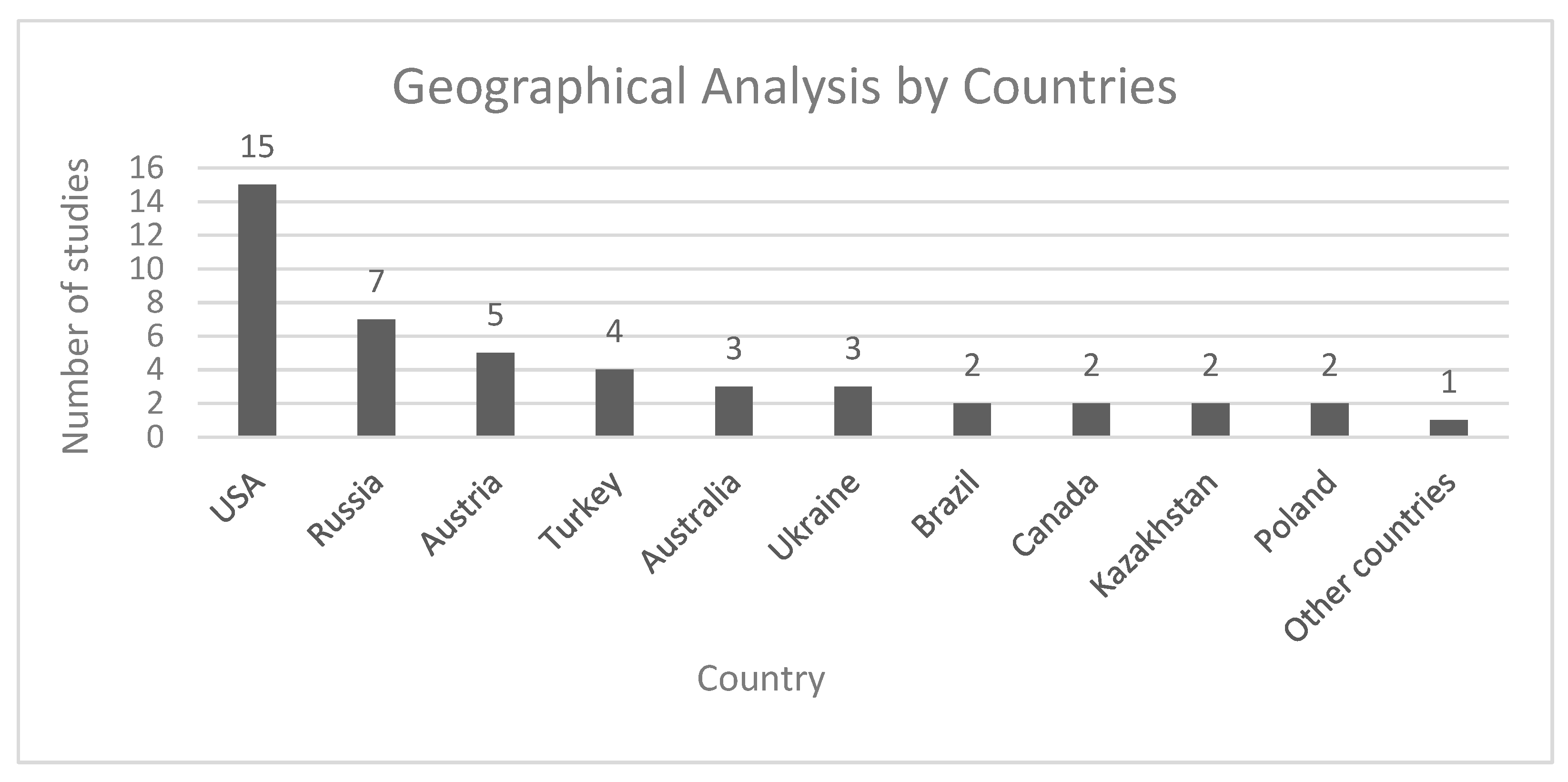Digital Tools to Support Personalized Education for Gifted Students: A Systematic Literature Review
Abstract
1. Introduction
2. Method
2.1. Search Strategy
2.2. Study Selection
2.3. Review Process and Coding
2.4. Quality Assessment
3. Results
3.1. Temporal Analysis
3.2. Geographic Analysis
3.3. Educational Stage
3.4. Curricular Areas
3.5. Personalization Approaches
3.6. Educational Benefits
3.7. Implementation Challenges
4. Discussion and Conclusions
Author Contributions
Funding
Institutional Review Board Statement
Informed Consent Statement
Data Availability Statement
Acknowledgments
Conflicts of Interest
Appendix A
| Tool/Platform | Short Description | URL |
|---|---|---|
| Renzulli Learning System | Personalized profiles and enrichment activities | https://renzullilearning.com |
| BE COOL! | Digital learning environment for gifted inclusion | https://doi.org/10.1007/s11423-020-09754-9 (accessed on 13 June 2025) |
| Scratch | Block-based coding platform | https://scratch.mit.edu |
| Kodu Game Lab | 3D game design for education | https://www.kodugamelab.com |
| LEGO Mindstorms EV3 | Robotics kit for STEM learning | https://www.lego.com/mindstorms |
| Arduino | Open-source electronics platform | https://www.arduino.cc |
| CindyJS | Math and interactive visualizations (JS) | https://cindyjs.org |
| GeoGebra | Dynamic math software | https://www.geogebra.org |
| TinkerPlots | Data visualization for students | https://www.tinkerplots.com |
| WISEngineering | Online environment for engineering projects | http://wiseengineering.org |
| Google Classroom | Learning management platform | https://classroom.google.com |
| Padlet | Collaborative digital boards | https://padlet.com |
| Flip (Flipgrid) | Short video-based learning | https://flip.com |
| OBS Studio | Open-source video recording and streaming | https://obsproject.com |
| YouTube | Video sharing and learning resource | https://www.youtube.com |
| DAWs (Ableton, FL Studio, Logic Pro) | Music production software | https://www.ableton.com/https://www.image-line.com/https://www.apple.com/logic-pro |
| Microsoft 365 (Word, PPT, Excel) | Productivity suite | https://www.microsoft365.com |
| Kahoot | Gamified quizzes | https://kahoot.com |
| Quizizz | Interactive quizzes | https://quizizz.com |
| LearningApps.org | Interactive learning activities | https://learningapps.org |
| Google Forms | Online surveys and quizzes | https://forms.google.com |
| Excel | Spreadsheet and data analysis | https://www.microsoft.com/excel |
| Open Journal Systems (OJS) | Open-source journal publishing | https://pkp.sfu.ca/ojs |
| 3D printers, robotics, modeling tools | STEAM education technologies | — |
| Digital Labs (Quant Kuban-KubSTU) | Digital lab environment (Russia) | — |
| VR + Haptic devices | Virtual reality and tactile feedback | — |
| Virtual Traditional Room (Vietnam) | VR school heritage project | — |
| Infographic and ICT apps | Mobile/cloud-based visual learning tools | — |
| 1 | |
| 2 | |
| 3 |
References
- Azbel, A. A., Ilyushin, L. S., & Kazakova, E. I. (2020, October 21–24). Using computer data processing in schoolchildren’s cross-cultural collaborative research. 2020 IEEE Frontiers in Education Conference (FIE 2020) (pp. 1–6), Uppsala, Sweden. [Google Scholar] [CrossRef]
- Bektenova, A., Bobrov, L., & Denissova, N. (2022). Formation of individual trajectories of giftedness of students based on the analysis of large data arrays. Journal of Theoretical and Applied Information Technology, 100(17), 5672–5682. Available online: https://www.jatit.org/volumes/Vol100No17/31Vol100No17.pdf (accessed on 20 March 2025).
- Bel, M., & Jarque Fernandez, M. (2014). First European experience in PCP process applied to education: IMAILE (Innovative methods for award procedures of ICT learning in Europe). In EDULEARN14 proceedings (pp. 3124–3125). IATED. Available online: https://library.iated.org/view/BEL2014FIR (accessed on 20 March 2025).
- Besnoy, K. D., Dantzler, J. A., & Siders, J. A. (2012). Creating a digital ecosystem for the gifted education classroom. Journal of Advanced Academics, 23(4), 305–325. [Google Scholar] [CrossRef]
- Calderero, J. F., Ocaña, A. M., Sánchez, A. C., Sirvent, R. M., & González, P. P. (2014). Una nueva aproximación al concepto de educación personalizada y su relación con las TIC. Teoría de la Educación. Educación y Cultura en la Sociedad de la Información, 15(2), 131–151. [Google Scholar] [CrossRef]
- Dewey, J. (2019). Progressive education and the science of education. Recherche Formation, 92(3), 71–82. [Google Scholar] [CrossRef]
- Dillon, L. (2010). Listening for voices of self: Digital journaling among gifted young adolescents. Qualitative Research Journal, 10(1), 13–27. [Google Scholar] [CrossRef]
- Dimitriadou, D., Emin, N., Kiremitsidou, P.-M., & Mpouzelou, S. (2024). The education of gifted students in Greece and Europe and the use of ICT. GSC Advanced Research and Reviews, 18(3), 124–141. [Google Scholar] [CrossRef]
- Dottrens, R. (1927). L’éducation nouvelle en Autriche [The new education in Austria]. Delachaux & Niestlé. [Google Scholar]
- Estarli, M., Barrera, E., Martínez-Rodríguez, R., Baladia, E., Durán Aguero, S., Camacho, S., Bonacich, K., Herrero-López, A., & Gil-González, D. (2016). Reference items for publishing protocols of systematic reviews and meta-analyses: 2015 PRISMA-P statement. Spanish Journal of Human Nutrition and Dietetics, 20, 148. [Google Scholar] [CrossRef]
- Eysink, T. H. S., van Dijk, A. M., & de Jong, T. (2020). BE COOL! A digital learning environment to challenge and socially include gifted learners. Educational Technology Research and Development, 68(5), 2373–2393. [Google Scholar] [CrossRef]
- García Hoz, V. (1993). Sobre los variados reflejos de la educación personalizada [On the varied reflections of personalized education]. Cuadernos de Pensamiento, 6(8), 9–14. Available online: https://dialnet.unirioja.es/servlet/articulo?codigo=244916 (accessed on 15 June 2024).
- Gilson, C. M., & Lee, L. E. (2023). Cultivating a learning environment to support diverse gifted students. Gifted Child Today, 46(4), 235–249. [Google Scholar] [CrossRef]
- Golubeva, O. V., Lebedeva, T. E., Gruzdeva, M. L., Chaykina, Z. V., & Mukhina, M. V. (2022). The mechanism for the implementation of innovative activities in additional educational institutions. In Education in the Asia-Pacific region (Vol. 65, pp. 407–414). Springer. [Google Scholar] [CrossRef]
- Hanushek, E. A. (2021). Addressing cross-national generalizability in educational impact evaluation. International Journal of Educational Development, 80, 102318. [Google Scholar] [CrossRef]
- Hazin, I., da Rocha Falcão, J. T., Reis, J., Felinto, P. M. B., & de Carvalho Souza, A. M. (2023). Talented children who develop digital artifacts and derive strength from them: An example from the Brazilian Metropolis Talent Project. Cultural-Historical Psychology, 19(2), 55–60. [Google Scholar] [CrossRef]
- Hinterplattner, S., Sabitzer, B., & Skogø, J. S. (2019). Interdisciplinary projects to promote gifted primary students and their digital competencies. In L. Chova, A. Martínez, & I. Torres (Eds.), ICERI2019 proceedings (pp. 8964–8967). IATED. [Google Scholar] [CrossRef]
- Hinterplattner, S., Sabitzer, B., & Skogø, J. S. (2021). Working on interdisciplinary projects to strengthen creative computational thinking and to support talent development. In Communications in computer and information science (pp. 317–340). Springer. [Google Scholar] [CrossRef]
- Ibragimova, A. N., & Ponomareva, A. A. (2020). Organization of legal education of gifted students using modern methodological tools. International Journal of Higher Education, 9(8), 79–83. [Google Scholar] [CrossRef]
- Isusqui, J. C. C. P., Villavicencio, I. E. S., Inga, C. V., Gutiérrez, H. O. C., Díaz, B. L. G., & Amaya, K. L. A. (2023). Artificial intelligence in the service of management and implementation in education [Preprint]. OSF Preprints. [Google Scholar] [CrossRef]
- Kalemis, K. (2014). Adapting cloud computing in education: Can we speak for an alternative didactic approach in school literacy in a cluster classroom for gifted and talented students? In F. Uslu (Ed.), Proceedings of the international conference on educational sciences (pp. 677–691). IATED. Available online: https://www.academia.edu/5497974/Adapting_Cloud_Computing_in_Education (accessed on 30 March 2024).
- Kara, N. (2019). Impact of digital media on gifted students’ career choices. Journal for the Education of Gifted Young Scientists, 7(2), 99–112. [Google Scholar] [CrossRef]
- Karpova, L., Shtefan, L., Kovalska, V., Ionova, O., & Luparenko, S. (2020). Information-educational environment as a condition of formation of gifted children’s informational-digital competence. Postmodern Openings, 11(2 Suppl. 1), 60–78. [Google Scholar] [CrossRef]
- Kelly, J., & Pohl, B. (2015). Flipping today’s classroom to meet the needs of 21st-century neo-millennial college students. In L. Chova, A. Martinez, & I. Torres (Eds.), Proceedings of the international conference on education and new learning technologies (p. 5805). IATED. Available online: https://library.iated.org/view/KELLY2015FLI (accessed on 30 March 2025).
- Lamb, P., & Aldous, D. (2014). The role of E-mentoring in distinguishing pedagogic experiences of gifted and talented pupils in physical education. Physical Education and Sport Pedagogy, 19(3), 301–319. [Google Scholar] [CrossRef]
- Landis, J. R., & Koch, G. G. (1977). The measurement of observer agreement for categorical data. Biometrics, 33(1), 159–174. [Google Scholar] [CrossRef]
- Maritain, J. (1966). The education of man: The educational philosophy of Jacques Maritain (D. A. Gallagher, & I. Gallagher, Eds.). Doubleday. Available online: https://archive.org/details/unset0000unse_g4f5?utm_source=chatgpt.com (accessed on 12 September 2025).
- Mastroberti, P. (2020, July 23–25). Developing a digital game with high-ability/gifted students in a low-income public school: A Brazilian experience. 14th International Conference on Interfaces and Human Computer Interaction 2020 and 13th International Conference on Game and Entertainment Technologies (pp. 144–152), Virtually. [Google Scholar] [CrossRef]
- Mercimek, B., Akbulut, Y., Dönmez, O., & Sak, U. (2020). Multitasking impairs learning from multimedia across gifted and non-gifted students. Educational Technology Research and Development, 68(3), 995–1016. [Google Scholar] [CrossRef]
- Montessori, M. (1949). The absorbent mind. Theosophical Publishing House. [Google Scholar]
- Mounier, E. (1949). Le personnalisme [El personalismo]. Éditions du Seuil. Available online: https://archive.org/details/mounier-emmanuel.-el-personalismo-ocr-1950-1972.?utm_source=chatgpt.com (accessed on 12 September 2025).
- Ozdemir, D. (2022). An examination of students’ views about an international math contest. International Electronic Journal of Mathematics Education, 17(2), em0680. [Google Scholar] [CrossRef] [PubMed]
- Page, M. J., McKenzie, J. E., Bossuyt, P. M., Boutron, I., Hoffmann, T. C., Mulrow, C. D., Shamseer, L., Tetzlaff, J. M., Akl, E. A., Brennan, S. E., Chou, R., Glanville, J., Grimshaw, J. M., Hróbjartsson, A., Lalu, M. M., Li, T., Loder, E. W., Mayo-Wilson, E., McDonald, S., … Moher, D. (2021). The PRISMA 2020 statement: An updated guideline for reporting systematic reviews. BMJ, 372, n71. [Google Scholar] [CrossRef] [PubMed]
- Parkhurst, H. (1922). Education on the Dalton Plan. E. P. Dutton. Available online: https://archive.org/details/educationontheda028244mbp (accessed on 13 June 2025).
- Pérez Guerrero, J., & Ahedo Ruiz, J. (2020). La educación personalizada según García Hoz [Personalized education according to García Hoz]. Revista Complutense de Educación, 31(1), 1–9. [Google Scholar] [CrossRef]
- Pérez-Pueyo, Á., Alcalá, D. H., Gutiérrez-García, C., & Garijo, A. H. (2019). Andamiaje y evaluación formativa: Dos caras de la misma moneda [Scaffolding and formative assessment: Two sides of the same coin]. Revista Infancia, Educación y Aprendizaje, 5(2), 559–565. [Google Scholar] [CrossRef]
- Piaget, J. (1981). Intelligence and affectivity: Their relationship during child development. Annual Reviews Inc. [Google Scholar]
- Portela, M., & Garcia Fernandez, G. (2018, March 5–7). Challenging the challengers: Technology-enhanced math mentorship for gifted students in an international baccalaureate curricular context (MATEMENTOR Project). 12th International Technology, Education and Development Conference (pp. 8434–8442), Valencia, Spain. [Google Scholar] [CrossRef]
- Pozo, J. I. (1989). Teorías cognitivas del aprendizaje [Cognitive theories of learning]. Morata. [Google Scholar]
- Renzulli, J., Reis, S., & Shaughnessy, M. F. (2014). A reflective conversation with Joe Renzulli and Sally Reis: About the Renzulli learning system. Gifted Education International, 30(1), 24–32. [Google Scholar] [CrossRef]
- Román-González, M. (2014). Aprender a programar “apps” como enriquecimiento curricular en alumnado de alta capacidad. Bordón, 66(4), 135–155. [Google Scholar] [CrossRef]
- Román-González, M., & González Galán, M. A. (2019). Individualización, diferenciación y personalización en la sociedad digital. In Attention to diversity and differential pedagogy. UNED. Available online: https://dialnet.unirioja.es/servlet/articulo?codigo=7463725 (accessed on 30 March 2024).
- Ronksley-Pavia, M., & Neumann, M. M. (2022). Exploring educator leadership practices in gifted education to facilitate online learning experiences for (re)engaging gifted students. Education Sciences, 12(2), 99. [Google Scholar] [CrossRef]
- Schwinghammer, M., Milisic, D., Schmidthaler, E., & Sabitzer, B. (2023). The “cOOL clubs”: Supporting gifted primary school students in STEAM. In Proceedings of the 28th ACM conference on innovation and technology in computer science education V.1 (pp. 384–390). ACM. [Google Scholar] [CrossRef]
- Shubina, I., & Kulakli, A. (2019). Pervasive learning and technology usage for creativity development in education. International Journal of Emerging Technologies in Learning, 14(1), 4–21. [Google Scholar] [CrossRef]
- Soboleva, E. V., Suvorova, T. N., Bocharov, M. I., & Bocharova, T. I. (2022). Using game mechanics in professional training of future teachers working with gifted children. European Journal of Contemporary Education, 11(4), 1222–1235. [Google Scholar] [CrossRef]
- Su, H. (2020). Who are information and communication technology talents? A literature review. Human Behavior and Emerging Technologies, 2(3), 288–297. [Google Scholar] [CrossRef]
- Torres-Torres, Y.-D., Román-González, M., & Pérez-González, J.-C. (2021, October 26–29). Specific didactic strategies used for the development of computational thinking in the female collective in primary and secondary education: A systematic review protocol. The Ninth International Conference on Technological Ecosystems for Enhancing Multiculturality (TEEM’21) (pp. 25–29), Barcelona, Spain. [Google Scholar] [CrossRef]
- Vouglanis, T. (2018). The use of ICT in the cognitive and meta-cognitive skills of gifted children [Ph.D. dissertation, University of the Aegean]. Available online: https://www.researchgate.net/publication/369734352 (accessed on 14 June 2024).
- Vygotsky, L. S. (1978). Mind in society: The development of higher psychological processes. Harvard University Press. [Google Scholar] [CrossRef]
- Washburne, C. W. (1922). Educational measurement as a key to individual instruction and promotions. (Reprinted from the Journal of Educational Research, March 1922). Available online: https://catalog.hathitrust.org/Record/100659136 (accessed on 13 June 2025).
- Wood, D. J., Bruner, J. S., & Ross, G. (1976). The role of tutoring in problem solving. Journal of Child Psychology and Psychiatry, 17(2), 89–100. [Google Scholar] [CrossRef]
- Zambo, D. (2009). Gifted students in the 21st century: Using Vygotsky’s theory to meet their literacy and content area needs. Gifted Education International, 25(3), 270–280. [Google Scholar] [CrossRef]
- Zverev, O., & Sergeeva, T. (2020). Designing a professional training program for working with gifted children using Office 365 software. Mathematics and Informatics, 63(3), 291–296. Available online: https://mathinfo.azbuki.bg/en/matematics/sp-matematika-i-informatika-knizhka-3-2020-godina-lxiii/ (accessed on 15 June 2025).





| Characteristic | Individualization | Differentiation | Personalization |
|---|---|---|---|
| Objectives and Content | Constant for all students | Constant for all students | Adjusted to each learner’s needs, preferences, and interests |
| Learning Pace | Adapted to each student | Generally constant, with some variation | Adapted to each student |
| Teaching Methodology | Constant, focused on allowing different learning rates | Adaptable and varied according to the needs of student groups | Fully tailored to each learner’s needs, preferences, and interests |
| Research Design | Number of Studies | % of Total | Examples of Methods Reported |
|---|---|---|---|
| Mixed-method | 23 | 41.1% | Questionnaires + log-file analysis, surveys + case studies |
| Qualitative | 22 | 39.3% | Interviews, case studies, observations, vignettes |
| Quantitative | 10 | 17.9% | Surveys, pre–post tests, comparative analyses |
| Unspecified/Other | 1 | 1.8% | Labeled as “Study Type (quantitative, qualitative, mixed)” |
Disclaimer/Publisher’s Note: The statements, opinions and data contained in all publications are solely those of the individual author(s) and contributor(s) and not of MDPI and/or the editor(s). MDPI and/or the editor(s) disclaim responsibility for any injury to people or property resulting from any ideas, methods, instructions or products referred to in the content. |
© 2025 by the authors. Licensee MDPI, Basel, Switzerland. This article is an open access article distributed under the terms and conditions of the Creative Commons Attribution (CC BY) license (https://creativecommons.org/licenses/by/4.0/).
Share and Cite
Vidal-Fernández, A.; Martínez-Algora, C.; Román-González, M. Digital Tools to Support Personalized Education for Gifted Students: A Systematic Literature Review. Educ. Sci. 2025, 15, 1257. https://doi.org/10.3390/educsci15091257
Vidal-Fernández A, Martínez-Algora C, Román-González M. Digital Tools to Support Personalized Education for Gifted Students: A Systematic Literature Review. Education Sciences. 2025; 15(9):1257. https://doi.org/10.3390/educsci15091257
Chicago/Turabian StyleVidal-Fernández, Ana, Cipriano Martínez-Algora, and Marcos Román-González. 2025. "Digital Tools to Support Personalized Education for Gifted Students: A Systematic Literature Review" Education Sciences 15, no. 9: 1257. https://doi.org/10.3390/educsci15091257
APA StyleVidal-Fernández, A., Martínez-Algora, C., & Román-González, M. (2025). Digital Tools to Support Personalized Education for Gifted Students: A Systematic Literature Review. Education Sciences, 15(9), 1257. https://doi.org/10.3390/educsci15091257







